

Portal:Energy. European super grid. A conceptual plan of a European super grid linking renewable energy projects like DESERTEC & Medgrid across North Africa, the Middle East and Europe and could serve as the backbone for the hypothetical supersmart grid.
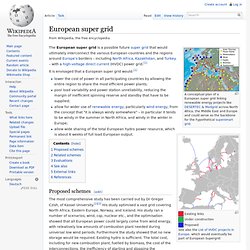
The European super grid is a possible future super grid that would ultimately interconnect the various European countries and the regions around Europe's borders – including North Africa, Kazakhstan, and Turkey. – with a high-voltage direct current (HVDC) power grid.[1] It is envisaged that a European super grid would:[1] Proposed schemes[edit] The most comprehensive study has been carried out by Dr Gregor Czish, of Kassel University.[2][3] His study optimised a vast grid covering North Africa, Eastern Europe, Norway, and Iceland. His study ran a number of scenarios, wind, csp, nuclear etc., and the optimisation showed that all European power could largely come from wind energy, with releatively low amounts of combustion plant needed during universal low wind periods. Let's Build a Planetary Energy Transmitter. LUNA RING/Shimizu's Dream - Shimizu Corporation. The Energy Paradigm Shift Opens the Door to a Sustainable Society A shift from economical use of limited resources to the unlimited use of clean energy is the ultimate dream of all mankind.
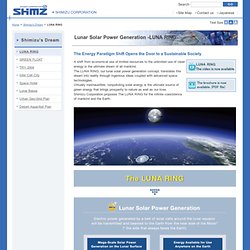
The LUNA RING, our lunar solar power generation concept, translates this dream into reality through ingenious ideas coupled with advanced space technologies. Virtually inexhaustible, nonpolluting solar energy is the ultimate source of green energy that brings prosperity to nature as well as our lives. Shimizu Corporation proposes The LUNA RING for the infinite coexistence of mankind and the Earth.
CrowdInvesting in Climate and Clean Energy Innovation. List of energy storage projects. This is a list of energy storage projects worldwide.

Many individual energy storage projects augment electrical grids by capturing excess electrical energy during periods of low demand and storing it in other forms until needed on an electrical grid. The energy is later converted back to its electrical form and returned to the grid as needed. Another energy storage method is the consumption of surplus or low-cost energy (typically during night time) for conversion into resources such as hot water, cool water or ice, which is then used for heating or cooling at other times when electricity is in higher demand and at greater cost per kilowatt hour (KWh). Portal:Sustainable development. DESERTEC Foundation: Start. Desertec. DESERTEC is a project supported by a foundation of the same name and the consortium Dii (Desertec industrial initiative) created in Germany as a limited liability company (GmbH).[2] The project aims at creating a global renewable energy plan based on the concept of harnessing sustainable power from sites where renewable sources of energy are more abundant and transferring it through high-voltage direct current transmission to consumption centers.

All kinds of renewable energy sources are envisioned, but the sun-rich deserts of the world play a special role.[1] By taking into account land and water use, DESERTEC is intended to offer an integrated solution to food and water shortages in the coming decades. [why?] [3][4][5] Organizations, Milestones and Activities[edit] TREC[edit] The red squares represent the area that would be enough for solar power plants to produce a quantity of electricity consumed by the world today, in Europe (EU-25) and Germany (De). Renewable Energy. Portal:Renewable energy. Alternative Energy. Geothermal electricity. Geothermal electricity is electricity generated from geothermal energy.
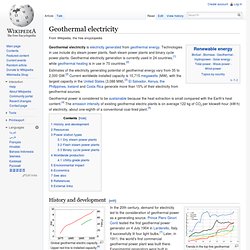
Technologies in use include dry steam power plants, flash steam power plants and binary cycle power plants. Geothermal electricity generation is currently used in 24 countries,[1] while geothermal heating is in use in 70 countries.[2] Estimates of the electricity generating potential of geothermal energy vary from 35 to 2,000 GW.[2] Current worldwide installed capacity is 10,715 megawatts (MW), with the largest capacity in the United States (3,086 MW).[3] El Salvador, Kenya, the Philippines, Iceland and Costa Rica generate more than 15% of their electricity from geothermal sources. Geothermal power is considered to be sustainable because the heat extraction is small compared with the Earth's heat content.[4] The emission intensity of existing geothermal electric plants is on average 122 kg of CO 2 per kilowatt-hour (kW·h) of electricity, about one-eighth of a conventional coal-fired plant.[5]
L'EnerGeek : l'énergie facile en quelques clics ! Clean, Free Energy. Category:Lists related to renewable energy. Smart grid. A smart grid is a modernized electrical grid that uses analog[1] or digital information and communications technology to gather and act on information - such as information about the behaviours of suppliers and consumers - in an automated fashion to improve the efficiency, reliability, economics, and sustainability of the production and distribution of electricity.[2] Electronic power conditioning and control of the production and distribution of electricity are important aspects of the smart grid.
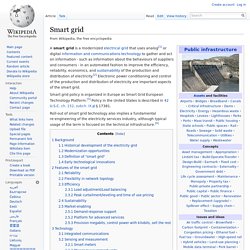
Smart grid policy is organized in Europe as Smart Grid European Technology Platform.[3] Policy in the United States is described in 42 U.S.C. ch. 152, subch. IX § 17381. SuperSmart Grid — PIK Research Portal. Since 2007, we have focused our work on two broad and closely interconnected questions: (1) whether it is desirable for Europe to achieve 100% renewables in cooperation with North Africa (energy security block), and (2) how Europe, alone or in cooperation with others, can achieve the infrastructure necessary to generate and integrate 100% renewables (policy block).
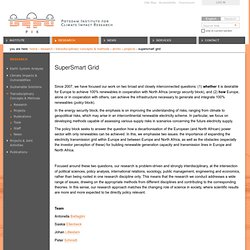
In the energy security block, the emphasis is on improving the understanding of risks, ranging from climate to geopolitical risks, which may arise in an intercontinental renewable electricity scheme. In particular, we focus on developing methods capable of assessing various supply risks in scenarios concerning the future electricity supply. The policy block seeks to answer the question how a decarbonisation of the European (and North African) power sector with only renewables can be achieved. Team Antonella Battaglini Saskia Ellenbeck Johan Lilliestam Peter Schmidt Publications.